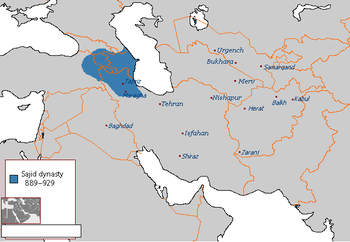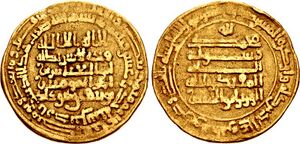بنو الساج
Sajid dynasty ساجیان | |||||||||
|---|---|---|---|---|---|---|---|---|---|
| 889–929 | |||||||||
 Map of the Sajid dynasty at its greatest extent | |||||||||
| العاصمة | Maragha (889-901) Ardabil (901-929) | ||||||||
| اللغات الشائعة | Persian | ||||||||
| الدين | Sunni Islam | ||||||||
| الحكومة | Monarchy | ||||||||
| Afshin | |||||||||
• 889–901 | Muhammad ibn Abi'l-Saj | ||||||||
• 928–929 | Abu'l-Musafir al-Fath (last) | ||||||||
| الحقبة التاريخية | Middle Ages | ||||||||
• تأسست | 889 | ||||||||
• انحلت | 929 | ||||||||
| |||||||||
| Today part of | |||||||||
جزء من سلسلة عن |
|---|
| تاريخ إيران |
 |
|
خط زمني |
بنو الساج سلاسة مسلمة حكمت في أذربيجان ومراغة وأردبيل وبردع من نحو سنة 267 إلى 318 هـ، وهي السنة التي استرد فيها العباسيون الحكم على هذا المِصر.[1]
يعود أصل الأسرة الساجية إلى إقليم أشروسنة في بلاد ما وراء النهر، ومع أنها كانت في بادئ الأمر تدافع عن الخلافة العباسية سرعان ما تغير موقفها، بسبب ضعف دولة الخلافة، واستطاعت السيطرة على بلاد أرمينية وأذربيجان، مؤسسين أسرة حاكمة صغيرة شبه مستقلة عن الخلافة العباسية.[2]
التاريخ
At the end of the ninth century (898-900) coins were minted named after Muhammad ibn Abu Saj. Muhammad ibn Abu Saj succeeded in incorporating much of the South Caucasus into the Sajid state. The first capital of Sajids was Maragha though they usually resided in Barda.[3][4][5]
Yusuf ibn Abi’l-Saj came to power in 901 and demolished the walls of Maragha and moved the capital to Ardabil. The eastern borders of the Sajid dynasty extended to the shores of the Caspian Sea, and the western borders to the cities of Ani and Dabil (Dvin). Yusuf ibn Abi’l-Saj relations with the caliph were not good. In 908, a caliphate army was sent against Yusuf, but al-Muqtafi died and his successor, al-Muqtadir, moved a large army against Yusuf ibn Abi’l-Saj and forced him to pay a tribute of 120 thousand dinars a year. Abu’l-Hasan Ali ibn al-Furat the vizier of al-Muqtadir, played a key role in establishing peace, and since then Yusuf ibn Abi’l-Saj considered him his patron in Baghdad and often mentioned him on his coins. Peace allowed Yusuf ibn Abi’l-Saj to receive investiture of the governorship in Azerbaijan by the caliph in 909.[6][7][8]
After the dismissal (in 912) of his protector in Baghdad, vizier ibn al-Furat, Yusuf ibn Abi’l-Saj stopped annual tax payments to the caliphate’s treasury.[9][3]
 عملة يوسف بن أبي الساج. |
According to the Azerbaijani historian Abbasgulu aga Bakikhanov, from 908-909 to 919, the Sajids made the Shirvanshah Mazyadids dependent on them. Thus, at the beginning of the X century, the Sajid state included territories from Zanjan in the south to Derbent in the north, the Caspian Sea in the east, to the cities of Ani and Dabil in the west, covering most of the lands of modern Azerbaijan.[9]
During the reign of Yusuf ibn Abi'l-Saj, Russian raiders attacked the Sajid territory from the north via the Volga in 913-914. Yusuf ibn Abu Saj repaired the Derbent wall to strengthen the northern borders of the state. He also rebuilt the collapsed part of the wall inside the sea.[10]
In 914, Yusuf ibn Abi’l-Saj organized a campaign towards Georgia. Tbilisi was chosen as the center of military operations. He first occupied Kakheti and captured the fortresses of Ujarma and Bochorma, and returned after capturing several territories.[11][3]
After the death of Yusuf ibn Abu Saj, the last ruler of the Sajid dynasty Fath b. Muhammad b. Abi 'l-Saj was poisoned in Ardabil by one of his slaves, which ended the Sajid dynasty and enabled eventual expansion of the Sallarid dynasty into Azerbaijan in 941.[3][11]
قائمة الحكام
حسب زامباور:
| الحاكم | تعليقات | انتهى حكمه سنة |
|---|---|---|
| أبو الساج ديوداد [الأول] بن ديودست | توفي بجنديسابور سنة 266 هـ | - |
| أبو المسافر [أبو عبيد الله] محمد الأفشين بن ديوداد | توفي في ربيع الأول 288هـ | سنة 276 هـ |
| ديوداد [الثاني] بن محمد | - | ربيع الأول 288 هـ |
| أبو القاسم يوسف بن ديوداد | - | شعبان 288 هـ/928م |
| أبو المسافر فتح بن محمد | - | ذو الحجة 315 هـ |
انظر أيضاً
المصدر
- ^ الموسوعة العربية الميسرة - المجلد الأول. المكتبة العصرية. p. 790.
{{cite book}}: Cite has empty unknown parameters:|lay-date=,|subscription=,|nopp=,|last-author-amp=,|name-list-format=,|lay-source=,|registration=, and|lay-summary=(help) - ^ مراد, حيدر خضير (2012 م). "الأفشين محمد أبي الساج (ت 288 هـ / 901 م) ودوره السياسي والعسكري في العصر العباسي الثاني". مجلة جامعة كربلاء العلمية. المجلد العاشر (العدد الرابع): 167. Retrieved 2 آب 2014 م.
{{cite journal}}: Check date values in:|accessdate=and|date=(help) - ^ أ ب ت ث Bayne Fisher, William, ed. (1975). The Cambridge History of Iran, Том 4. Cambridge University Press. ISBN 9780521200936.
- ^ Minorskiy, Vladimir (1957). Studies in Caucasian history. Cambridge University Press. p. 111.
- ^ "AZERBAIJAN iv. Islamic History to 1941 – Encyclopaedia Iranica". iranicaonline.org. Retrieved 2021-01-10.
- ^ Muir, William (2004). The Caliphate: Its Rise, Decline and Fall from Original Sources. Kessinger Publishing. ISBN 1417948892.
- ^ Kennedy, Hugh (2004). The Prophet and the Age of the Caliphates: The Islamic Near East from the 6th to the 11th Century (second ed.). Harlow: Longman. p. 190. ISBN 978-0-582-40525-7.
- ^ Madelung, W (1975). The Minor Dynasties of Northern Iran. Cambridge University Press. pp. 198–249. ISBN 0-521-20093-8.
- ^ أ ب Aliyarli, Suleyman (2009). History of Azerbaijan. Chirag. p. 209.
- ^ Василий Владимирович, Бартольд (1924). Место Прикаспийских областей в истории мусульманского мира. Баку.
{{cite book}}: CS1 maint: location missing publisher (link) - ^ أ ب ISMAILOV, DILGAM (2017). HISTORY OF AZERBAIJAN (PDF). Baku.
{{cite book}}: CS1 maint: location missing publisher (link) - ^ المستشرق زامباور (1400 هـ). معجم الأنساب والأسرات الحاكمة في التاريخ الإسلامي. بيروت: دار الرائد العربي - أخرجه زكي محمد حسن بك وحسن أحمد محمود وآخرون. p. 274.
{{cite book}}: Check date values in:|year=(help)
- CS1 maint: location missing publisher
- Pages using infobox country with unknown parameters
- بنو الساج
- سلالات حاكمة إيرانية
- سلالات حاكمة مسلمة
- أنظمة ملكية سابقة في آسيا
- القرن العاشر في أوروبا
- القرن التاسع في أوروبا
- القرن التاسع في آسيا
- انحلالات القرن العاشر في آسيا
- انحلالات سنة 929
- أذربيجان الإيرانية القروسطية
- أرمنيا القروسطية
- تاريخ إيران
- تاريخ جورجيا
- جورجيا في العصور الوسطى (بلد)
- دول وأقاليم انحلت في القرن العاشر
- دول سابقة في أوروبا
- دول سابقة في آسيا
- عائلات ملكية شرق أوسطية
- فارس الوسيطة